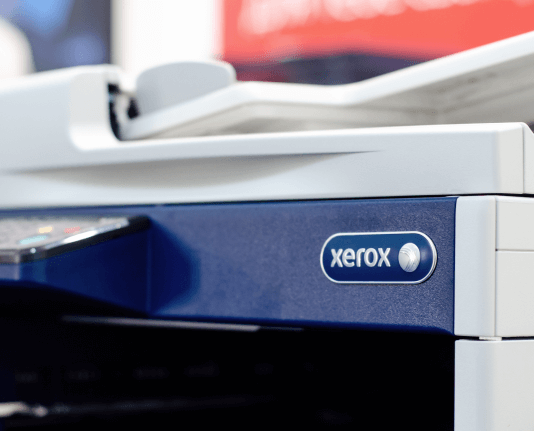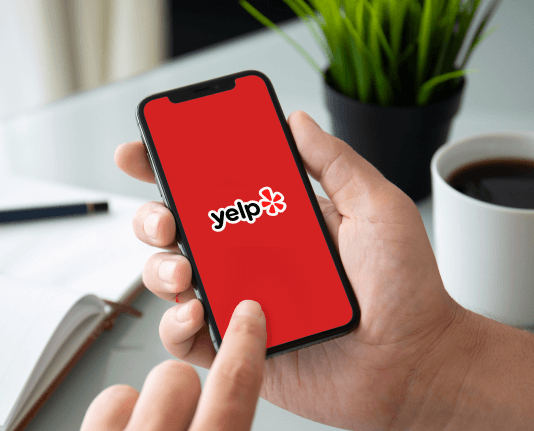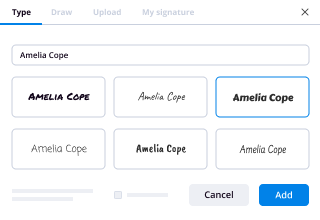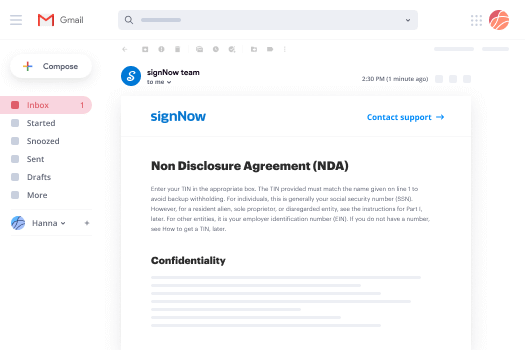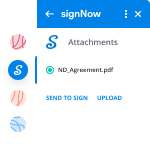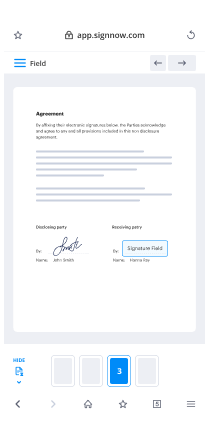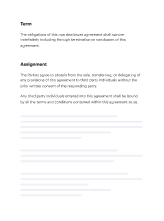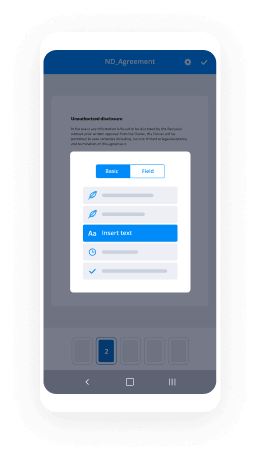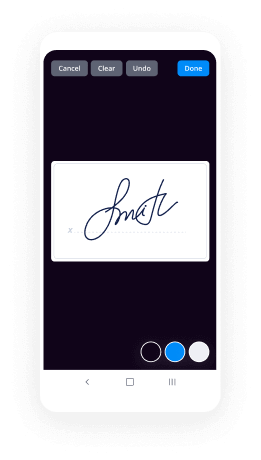How To Save Electronic signature in 1Password
Contact Sales
Make the most out of your eSignature workflows with airSlate SignNow
Extensive suite of eSignature tools
Robust integration and API capabilities
Advanced security and compliance
Various collaboration tools
Enjoyable and stress-free signing experience
Extensive support
Keep your eSignature workflows on track
Our user reviews speak for themselves






How to utilize 1password with airSlate SignNow
1password is an effective solution for handling your passwords securely, and when integrated with airSlate SignNow, it improves your document signing process. airSlate SignNow provides a smooth method to create, send, and sign documents electronically, making it an ideal option for organizations aiming for efficiency and cost savings. Here’s how to begin with airSlate SignNow and make the most of its features.
Step-by-step instructions for using 1password with airSlate SignNow
- Launch your web browser and go to the airSlate SignNow website.
- Establish a new account for a complimentary trial or log into your current account.
- Choose the document you want to sign or share for signing and upload it.
- If you intend to utilize this document later, convert it into a reusable template.
- Access your uploaded document and modify it as necessary: add fillable fields or insert essential information.
- Sign your document and assign signature fields for your recipients.
- Click on 'Continue' to set up and send an eSignature invitation.
By adhering to these steps, you can effectively employ airSlate SignNow for your electronic signing requirements. This platform offers businesses a wide range of features, ensuring that you gain substantial value for your investment.
So, embark on your journey with airSlate SignNow today and enjoy the advantages of streamlined document management and signing. Don’t hesitate to register for a complimentary trial and uncover how it can enhance your workflow!
How it works
Rate your experience
-
Best ROI. Our customers achieve an average 7x ROI within the first six months.
-
Scales with your use cases. From SMBs to mid-market, airSlate SignNow delivers results for businesses of all sizes.
-
Intuitive UI and API. Sign and send documents from your apps in minutes.
A smarter way to work: —how to industry sign banking integrate
FAQs
-
What is 1password and how does it work with airSlate SignNow?
1password is a secure password management tool that helps users store and manage their passwords and other sensitive information. When integrated with airSlate SignNow, 1password ensures that all your document signing processes are secure, allowing you to effortlessly access your airSlate SignNow account without compromising your security.
-
How can I integrate 1password with airSlate SignNow?
Integrating 1password with airSlate SignNow is simple. You can use the 1password browser extension to autofill your login credentials for airSlate SignNow, ensuring a seamless and secure login experience. This integration enhances your document signing efficiency while keeping your information safe.
-
What are the pricing options for using 1password with airSlate SignNow?
1password offers various pricing plans that cater to individuals and teams, making it accessible for all users. While airSlate SignNow has its own pricing structure, using 1password alongside airSlate SignNow can help streamline your document management processes, providing great value for your investment.
-
What features of 1password enhance my experience with airSlate SignNow?
1password offers features such as secure password storage, password sharing, and two-factor authentication that enhance your experience with airSlate SignNow. These features ensure that your sensitive documents and signing processes are protected, giving you peace of mind while managing your business operations.
-
Can I use 1password for team collaboration on airSlate SignNow?
Yes, 1password allows for secure team collaboration, making it an excellent companion for airSlate SignNow. You can share access to important documents and signing workflows with your team members while maintaining strict security protocols, ensuring everyone can contribute safely.
-
What are the benefits of using 1password with airSlate SignNow?
Using 1password with airSlate SignNow enhances overall security and efficiency. With easy access to your airSlate SignNow account and secure password management, you can focus on your document signing tasks without worrying about security bsignNowes or forgotten passwords.
-
Is there a trial version of 1password available for airSlate SignNow users?
1password offers a free trial for new users, allowing you to explore its features before making a commitment. This is particularly beneficial for airSlate SignNow users who want to experience enhanced security and convenience in managing their document signing processes.
-
Information Security: How much do electronic signatures cost?
signNow is an Apple & Google loved secure e-signature solution. Pricing merely depends your requirement. Check out the pricing of signNow here.
-
How does 1password work and do they really not save passwords?
The long answer is in the 1Password Security Design document of which I am the principal author, but it is a very long answer.The short answer is that we really do not have your passwords, and this is done through the magic of mathematics.The slightly longer answerThere are two things that you will to to know about to understand how this all works. The first thing you need to know is what encryption is. Encryption is a process that turns meaningful data into stuff that is indistinguishable from random. It transforms the data (in this case your passwords or other things you might store in 1Password) into gibberish. This transformation involves a secret, called a key. The key is needed to turn the gibberish back into its original form.Without the key it is impossible to transform the encrypted data back into its original form. Some terminology: The original data is called plaintext, and the encrypted data, which is indistinguishable from random, is called the ciphertext. Everything about how the encryption process works can (and should) be publicly known. Only the key needs to be kept secret.Where does your key come from?The second thing you need to know about is something called a key derivation function (KDF). I will talk a little bit about keys before explaining that.The kinds of keys that the encryption system we use is a number that would be about 77 digits long (if ever written out in decimal form). It is 256 binary digits long. Only you should ever have the key that is needed to turn your ciphertext back into plaintext, but you aren’t going to remember or type a 77 digit random number every time you want to unlock your data. Instead your key is computed via a KDF.The simplest sort of KDF would transform your 1Password Master Password into a key. Remember that the “F” in “KDF” stands for “function”. So if you give the same master password, you derive the same key. A real KDF is more complicated in that it takes as input more than just your master password. It takes in something called a salt. Everyone gets their own salt so that if two different people use the same master password they won’t end up with the same key. The KDF is also designed to be computationally expensive. This is to slow down automated master password guessing if someone captures your data. And in the case of 1Password, the KDF also takes in something what we call a “Secret Key” (SK) (sorry, the term “key” gets used for many different things) which is something that only lives on your machines. Its role to to make sure that even if data is stolen from our servers, the attacker wouldn’t be able to make guesses at your master password as they would need the SK from your machine.Anyway, when you enter in your master password, 1Password will also read the salt and the SK from your machine and derive a key using the KDF. The derived key is then used to encrypt and decrypt stuff. All of this is done on your computer or device. Neither the plaintext nor the key is ever written to disk to transmitted our systems. Only the ciphertext is transmitted or saved to disk.It’s more complicatedWhat I’ve described above should give you an idea of how it is possible for a password manager, like 1Password, to do what it does. But there is actually a chain of keys. The key that is derived from the KDF is not actually used to encrypt your data directly. It is what is called a Key Encryption Key. It is used to encrypt another key (which we call your Master Unlock Key). And, in fact, there is a whole chain of keys. There are reasons for all of the complexity, but the main idea still holds. Your data is encrypted with keys that are encrypted with keys that … are encrypted with the key derived from your master password.
-
Is electronic signature legally binding in India?
Yes, e-signatures are legally valid in India. In fact, e-signatures have been recognized by the Indian law, with the passage of the Information Technology Act in year 2000.As per the IT Act, two types of signatures have the same legal status as handwritten signatures. These primarily include:(i) Digital Signatures: In this case, the signer is issued a long-term (1 to 2 year) certificate based digital ID stored on a USB token that can be used along with a personal PIN to sign a document.Note: Previously, the signer was issued a long-term (1 to 2 year) certificate based digital ID stored on a USB token that could be used along with a personal PIN to sign a document digitally. Now with Aadhaar, that complicated procedure isn’t required anymore. You can simply use signNow’s Aadhaar eSign to create a digital signature on the fly using your Aadhaar ID(ii) Electronic signatures: These electronic signatures combine Aadhaar identity number with an electronic Know-Your-Customer (eKYC) method (which includes sending an One-Time-Passcode to the mobile number linked to the Aadhaar card for verification)These Aadhaar based e-signatures and digital signatures are valid as long as they satisfy these conditions:(i) Electronic signatures must be uniquely linked to the person signing the document. (in the case of Aadhaar based signatures, they are linked by the unique Aadhaar ID)(ii) At the time if signing, the signatory must have control over the data used to generate the electronic signature (for eg: they should be able to directly affix the electronic signature to the document)(iii) There should be an audit trail of the steps taken during the signing the process(iv) In the case of digital signatures, signer certificates must be issued by signNowing Authority recognized by the Controller of signNowing Authorities appointed under the IT Act.Few of the exceptional cases in which documents cannot be signed electronically and must be executed using traditional handwritten signatures include:(i) Negotiable instruments such as a bill of exchange or a promissory note(ii) Powers of attorney(iii) Trust deeds(iv) Wills and any other testamentary disposition(v) Real-estate contracts such as leases or sales agreements.If you are looking to get legally compliant electronic signatures on contracts, invoices, quotes etc., try signNow, India’s first Aadhaar eSign solution that offers a complete fill-and-sign functionality with business workflows. Thus allowing users to finish their documents in one go.Here’s an informative ebook that will give you a brief overview of everything you need to know about electronic signature laws in some of the largest economies around the world: The Complete Guide to Electronic Signature Laws
-
In your opinion, how are electronic signatures better than handwritten “wet” signatures?
First of all, digital signatures offer a much higher security and convenience factor - most digital signature software out there comes with quite a few encryptions to keep your documents secure, there are digital trails that track every change that happens to the document (such as signature added/removed, or any other alteration), quite a few applications also show a progress bar of how the signing process is going, you can assign signatures, add remarks and stamps - all on your mobile device. There is no need to track the person to get their signature - just wait for them to sign. This is incredibly efficient compared to the ‘wet’ signatures. So, the main factors are security, speed, audit trails, process monitoring and the ability to do all these tasks on the go and on multiple devices/platforms.If you’re in the market for such an application that offers all these features and more, I suggest checking out signNow by Kdan. It’s intuitive, user-friendly and besides being highly secure, it’s a good fit for both small and medium-sized companies, individuals, start-ups and all kinds of businesses. While there is plenty of e-signature software out there, signNow stands out due to its well thought-out tools, well designed and user-friendly interface and it’s multi-platform, so there’s no need to compromise on anything.Disclaimer: I am part of Kdan’s team, and my answers might be a bit biased.
-
What is the best password management software for cross-platform use; comparing KeePass, 1Password, and LastPass? Best would be:
I used to teach a cyber security course to the spec ops community and at different points provided the students with either LastPass or 1Password. I have very little familiarity with KeePass and others. A few thoughts based on my experience:Choose 1Password if:You are Mac onlyYou highly value a gorgeous app (emphasis on Mac only - their Windows version is as ugly as the Mac version is beautiful)Your prefer a relatively steep upfront cost (~$50 or so, I think, plus $10-$15 for iOS app) to an ongoing subscription. You don't mind the cost jumping to $70 if you use both Windows and Mac.You need basic strong password generation and storage, confidence in the security of your password file, the convenience of browser extensions, and a good mobile app that will sync, and nothing else.Choose LastPass if:Free is important (note you won't get mobile access without paying)You use Windows (only or alongside Macs)You don't mind a less-than-pretty, less-than-intuitive designYou prefer $12/year (if you need the mobile app - otherwise it's free) to the high upfront cost of 1PWYou need any of the following features (in addition to those I mentioned above for 1PW): - 2 factor authentication - the ability to share access to a password with someone else (e.g. a spouse or employee). Note I said 'access' - they won't see the actual password unless you want them to, but will still be able to use it for log in. - Master password entry via an-screen keyboard (so you don't have to worry about key-loggers - for example in a hotel business center or an internet cafe) - 1-time passwords (useful for defeating key-loggers and for account recovery) - super-easy access to your passwords when using a computer other than your own. This is also possible using 1PW, but requires a little more work.As for me, I'm torn. I'm Mac only and love the 1PW UI, but I'm currently trying to force myself to migrate to LastPass for the sake of some of those extra features (especially the sharing).Hope this helps!
-
What is the advantage of using 1Password or similar apps on the Mac instead of Chrome's ability to save passwords and credit car
If you save your passwords in your browser, there are a number of security/privacy risks:- For one, anyone who uses your computer will be able to access all of the information you save in Chrome.- Next, if you use the sync functionality for Chrome auto-fill, so you can conveniently access the information wherever you use Chrome, then Google has access to all the information you sync to the cloud. And, well, Google thinks "it's good to know" everything about you.In terms of the advantages beyond security/privacy to using a password manager:- Smarter form-filling; you can have different identities (addresses, payment types, etc.) that you can easily toggle between... allowing for more accurate form-filling.- Generally, Chrome is only accurate when filling out a form at abouta 50-60% rate. There are better semantic form-fillers out there. (I'll plug my own start-up Dashlane's tech here: we fill in forms accurately at a rate of about 95%.)- A password manager will also help you select super-secure, unique passwords; help you upgrade your current ones.- A password manager (a good one, anyway) will locally-encrypt all your information and generally help you stay safe online.
-
What is the cost saving potential of digital/electronic signature solutions?
Strange though this might sound, many modern companies in the digital age are still blind to the electronic signature technology. As a consequence of this, they lose the opportunity to provide their customers with a better experience, higher productivity, and lower costs. We've repeatedly said about all these benefits but today we'd like to delve deeply into economic savings. The response was based on the calculated savings for the organization, which made the switch to the electronic signature app to get the above-mentioned advantages. For illustrative purposes, let us consider how much it...
-
What are the best electronic signature (e-signature) solutions on the market, in your opinion?
[full disclosure: I’m VP Digital Transformation at Solutions Notarius Inc., a company that supplies electronic and digital signature solutions]It completely depends on the requirements. I do not believe there is a uniquely better e-signature solution for all scenarios. For example, if the type of documents to be signed require low to medium reliability only, most modern e-signature platforms could be ok, subject to meeting legal requirements in the applicable jurisdiction, but if the document must meet stringent regulatory and statutory requirements that include high reliability of identity of signers, those platforms do not typically meet that threshold.Ideally, you would analyze, define and obtain agreement as to what constitutes the minimal acceptable legal reliability threshold you are willing to accept - or that readers of that document will accept. Next, define the technology requirements that correspond to that threshold. Finally, research e-signature options that meet these requirements and provide the best combination of price, features, scalability, etc..Finally, it should be noted that higher legal reliability e-signature platforms and solutions can always accommodate lower reliability documents while the converse is not true…
Trusted esignature solution— what our customers are saying
Get legally-binding signatures now!
Related searches to How To Save Electronic signature in 1Password
Frequently asked questions
How do i add an electronic signature to a word document?
How to provide authorize electronic signature?
How to make a greater than or equal to sign in a pdf?
Get more for How To Save Electronic signature in 1Password
Find out other How To Save Electronic signature in 1Password
- How to fill personal bond form malaysia
- Certified cost professional ccp certification study guide pdf form
- A not so bad bully answers key form
- Aig bank draft authorization form
- Access a ride application pdf form
- Rental application for residents and occupants form
- Prefix un worksheet pdf form
- Virginia simplified wall bracing calculation sheet form
- Work status form
- Rmc jaipur form
- Who what where worksheet form
- Class 8 science question paper form
- Telecare leeds form
- Salary to hourly chart form
- Wound care flow sheet form
- High school senior graduate status verification form
- Timed up and go test scoring pdf form
- Vision and hearing screening form
- Marking guide of national examination form
- Dawoodi bohra fajr namaz pdf form

